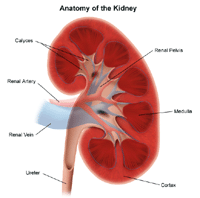What is a goiter?
A goiter is used to describe any enlarged thyroid gland. The thyroid is a butterfly-shaped gland located in your neck.
Is a goiter dangerous?
Goiters are relatively common. They are prevalent in about 5% of people in the United States. A goiter is typically not dangerous, unless the underlying cause of thyroid enlargement is a thyroid cancer. It is important to identify the cause of the goiter to rule out cancer.
Goiter Symptoms
When a goiter becomes large enough, it may appear as a swelling in the neck. A goiter is usually painless but may cause pressure-related symptoms, including:
- A feeling of neck fullness or tightness
- Difficulty swallowing
- Difficulty breathing
- Coughing
- Changes in your voice
Types of Goiters
There are several types of goiters.
Multinodular Goiter
When a goiter contains multiple nodules (small rounded lumps or masses), it’s called a multinodular goiter. Your doctor will evaluate each nodule by ultrasound and determine if any require a biopsy, to test for the presence of cancer.
Substernal Goiter
This is an enlargement of the thyroid gland that extends underneath the breastbone and possibly in between the lungs.
Goiter Causes
The most common cause of a goiter worldwide is a lack of iodine in the diet. In the United States, where iodized salt is readily available, goiters may be a result of the over- or underproduction of the thyroid hormone or the presence of nodules in the thyroid itself.
Goiter Treatment
Treatment for a goiter includes:
- Close observation
- Medication
- Surgery
- Radiofrequency ablation (RFA)
If your goiter is not causing any symptoms, your doctor may recommend close observation to monitor for any changes or growth over time. Medication to normalize abnormal thyroid hormone levels may be helpful in decreasing the size of the goiter. Surgery is typically recommended for a goiter that’s causing symptoms. A portion of the enlarged thyroid, if possible, or all of the thyroid, may need to be removed in a surgical procedure known as a
thyroidectomy.
When the goiter is caused by a noncancerous thyroid nodule(s), a new technique, called
radiofrequency ablation (RFA), may be used to shrink the goiter, and alleviate pressure-related symptoms, without the need for surgery.
Goiter Removal
If you require surgery to remove the goiter, your surgeon will determine the best approach for removal. Some or all of thyroid may be removed via a
scarless technique. If a neck incision must be made, the smallest incision possible will be used to allow for a safe removal of the affected thyroid gland.
If the goiter extends underneath the breastbone significantly, a small cut in your breastbone may need to be made to safely remove it. This typically requires an experienced thyroid surgical team to optimize outcomes.







